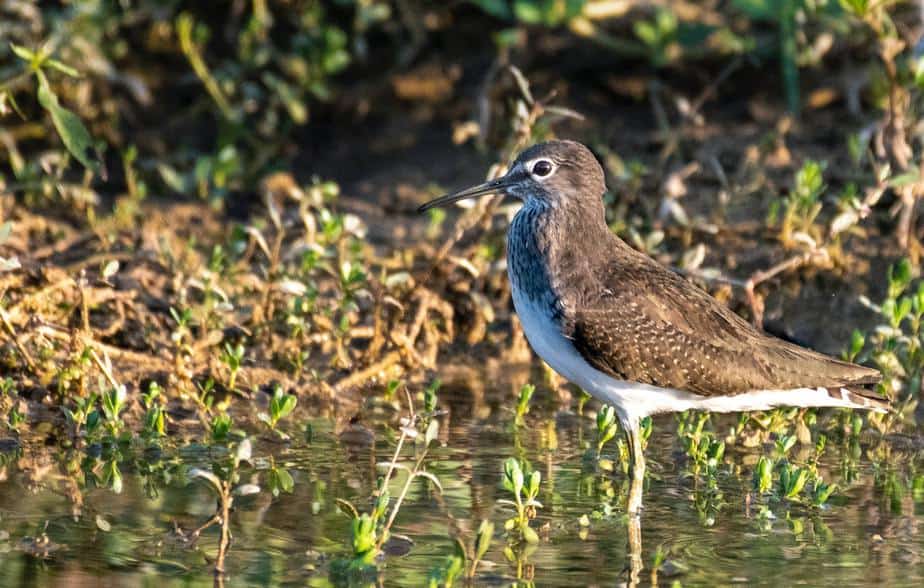Reflections on Elizabeth Bishop’s “Sandpiper”
Carrie Hohmann Campbell
With the end of summer rapidly approaching and the next schoolyear already begun, I am reminded of Elizabeth Bishop’s “Sandpiper”. As a child, late August meant my family would travel from the Pennsylvania woods to the Atlantic shoreline a week or two before our northern schoolyear began. Perfect timing for the water to be warm and the prices to be low, as schools in the South begin the schoolyear in early August. Myrtle Beach, North Myrtle, Kitty Hawk, Tybee Island, Jekyll Island, Hilton Head, Isle of Palms—all different locations and types of beaches that marked the memory of my adolescence. Some were more touristy than others, whether crowded with people or high rises or both. Some were without lights at night or much human activity—those were (and still are) my favorites. But whatever the beach, the shorebirds—seagulls, terns, pelicans, and sandpipers—gathered. My dad (the science teacher) always pointed out the differences in size, disposition, and defining features. I especially enjoyed observing the sandpiper flit toward and away from the water’s edge.
When I discovered Elizabeth Bishop’s “Sandpiper” in my first college poetry course, all the nostalgic beach imagery flooded my memory. This poem is not her most famous or anthologized (see “The Map”, “One Art”, “Sestina” “In the Waiting Room”, etc.). Nor is its title one that she agonized over (“One Art” went through many less elegant iterations). And Bishop has written several other poems about several other animals (see “The Fish”, “The Moose”, etc.). But “Sandpiper” links a poem—one that uses intense imagery, a subtle construction of stanzas, and a mastery of formal verse—to one of my favorite natural settings. I return to all of Bishop’s work regularly for her ability to capture human experience through those poetic qualities.
Even though I mostly create informal verse, I’m drawn to the order Bishop instills within “Sandpiper”: five quatrains of rhymed verse that creates a rhythm and uneven lengths that mimic the water undulating against the shore. Her use of rhyme in every other line creates a rhythm which never allows the pace to stall. And her keen poetic eye is every bit as sensitive and meticulous as her subject’s. Her description of the bird running “in a state of controlled panic” ignoring the water rushing “over his dark and brittle feet” recalled the many occasions I’ve witnessed these birds rush toward or scurry away from the water if the wave was too large. And while this “controlled panic” is attributed to the bird, its metaphor for human conduct is too close to be overlooked. “[F]inical, awkward”—can easily convey human actions and the reader is able to project themselves onto the bird. This personification seems natural as most humans are searching for “something, something, something” with such a narrowed focus that they may miss the beauty beside (and within) the banal (Bishop’s obvious nod to Blake’s “To see a World in a Grain of Sand…” from “Auguries of Innocence”).
While her visual description allows readers to imagine the scene, Bishop’s use of other sensory experiences make the scene feel complete. The sounds Bishop employs within the poem (“roaring alongside” and the hissing of the beach) drown out the noise of the larger world, which is a welcomed change to the constant thoughts racing through my head. Along with the sounds of the shore, I enjoy her repetition as it mimics the bird’s actions and emphasizes his mania and obsession with finding whatever the “something, something, something”. But the sandpiper’s actions—constant running and watching—make me instantly think of humanity, at least first-world humanity, as people continuously rush about with their attention divided between the past and future. This projection of self is commonplace since there’s also something good in the obsession, in the determination to keep searching and to avoid distraction. Seeing ourselves in the bird suggests a comparison between what and how he is seeking mirrors human resolve. The perseverance of the sandpiper to find what he seeks while the ocean thunders and the ground quakes makes his anxious actions admirable; he will continue despite obstacles, even ignoring them by running “straight through, watching his toes”—a singular focus on his end goal. And what more can we ask but to keep moving amidst the roaring?
Sandpiper—Elizabeth Bishop The roaring alongside he takes for granted, and that every so often the world is bound to shake. He runs, he runs to the south, finical, awkward, in a state of controlled panic, a student of Blake. The beach hisses like fat. On his left, a sheet of interrupting water comes and goes and glazes over his dark and brittle feet. He runs, he runs straight through it, watching his toes. –Watching, rather, the spaces of sand between them where (no detail too small) the Atlantic drains rapidly backwards and downwards. As he runs, he stares at the dragging grains. The world is a mist. And then the world is minute and vast and clear. The tide is higher or lower. He couldn’t tell you which. His beak is focussed; he is preoccupied, looking for something, something, something. Poor bird, he is obsessed! The millions of grains are black, white, tan, and gray mixed with quartz grains, rose and amethyst.
Carrie Hohmann Campbell is the author of the chapbooks Drawn to Extinction (Finishing Line Press) and incongruent: someday (dancing girl press). She lives with her family in northwestern Pennsylvania where she precariously balances teaching creative writing at Edinboro University, homesteading, raising two energetic humans, and writing.




